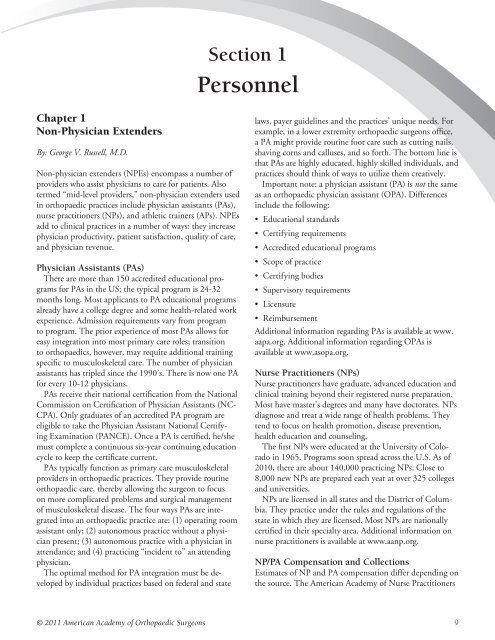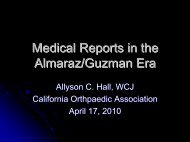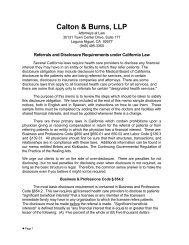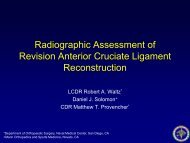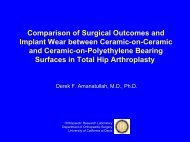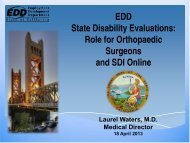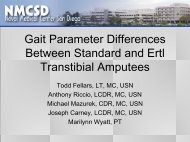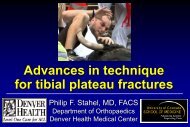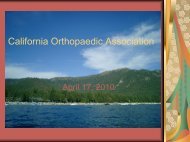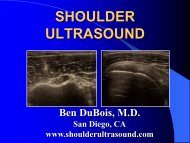Enhancing Your Practice's Revenue - California Orthopaedic ...
Enhancing Your Practice's Revenue - California Orthopaedic ...
Enhancing Your Practice's Revenue - California Orthopaedic ...
- No tags were found...
You also want an ePaper? Increase the reach of your titles
YUMPU automatically turns print PDFs into web optimized ePapers that Google loves.
Section 1PersonnelChapter 1Non-Physician ExtendersBy: George V. Russell, M.D.Non-physician extenders (NPEs) encompass a number ofproviders who assist physicians to care for patients. Alsotermed “mid-level providers,” non-physician extenders usedin orthopaedic practices include physician assistants (PAs),nurse practitioners (NPs), and athletic trainers (APs). NPEsadd to clinical practices in a number of ways: they increasephysician productivity, patient satisfaction, quality of care,and physician revenue.Physician Assistants (PAs)There are more than 150 accredited educational programsfor PAs in the US; the typical program is 24-32months long. Most applicants to PA educational programsalready have a college degree and some health-related workexperience. Admission requirements vary from programto program. The prior experience of most PAs allows foreasy integration into most primary care roles; transitionto orthopaedics, however, may require additional trainingspecific to musculoskeletal care. The number of physicianassistants has tripled since the 1990’s. There is now one PAfor every 10-12 physicians.PAs receive their national certification from the NationalCommission on Certification of Physician Assistants (NC-CPA). Only graduates of an accredited PA program areeligible to take the Physician Assistant National CertifyingExamination (PANCE). Once a PA is certified, he/shemust complete a continuous six-year continuing educationcycle to keep the certificate current.PAs typically function as primary care musculoskeletalproviders in orthopaedic practices. They provide routineorthopaedic care, thereby allowing the surgeon to focuson more complicated problems and surgical managementof musculoskeletal disease. The four ways PAs are integratedinto an orthopaedic practice are: (1) operating roomassistant only; (2) autonomous practice without a physicianpresent; (3) autonomous practice with a physician inattendance; and (4) practicing “incident to” an attendingphysician.The optimal method for PA integration must be developedby individual practices based on federal and statelaws, payer guidelines and the practices’ unique needs. Forexample, in a lower extremity orthopaedic surgeons office,a PA might provide routine foot care such as cutting nails,shaving corns and calluses, and so forth. The bottom line isthat PAs are highly educated, highly skilled individuals, andpractices should think of ways to utilize them creatively.Important note: a physician assistant (PA) is not the sameas an orthopaedic physician assistant (OPA). Differencesinclude the following:• Educational standards• Certifying requirements• Accredited educational programs• Scope of practice• Certifying bodies• Supervisory requirements• Licensure• ReimbursementAdditional information regarding PAs is available at www.aapa.org. Additional information regarding OPAs isavailable at www.asopa.org.Nurse Practitioners (NPs)Nurse practitioners have graduate, advanced education andclinical training beyond their registered nurse preparation.Most have master’s degrees and many have doctorates. NPsdiagnose and treat a wide range of health problems. Theytend to focus on health promotion, disease prevention,health education and counseling.The first NPs were educated at the University of Coloradoin 1965. Programs soon spread across the U.S. As of2010, there are about 140,000 practicing NPs. Close to8,000 new NPs are prepared each year at over 325 collegesand universities.NPs are licensed in all states and the District of Columbia.They practice under the rules and regulations of thestate in which they are licensed. Most NPs are nationallycertified in their specialty area. Additional information onnurse practitioners is available at www.aanp.org.NP/PA Compensation and CollectionsEstimates of NP and PA compensation differ depending onthe source. The American Academy of Nurse Practitioners© 2011 American Academy of <strong>Orthopaedic</strong> Surgeons9


